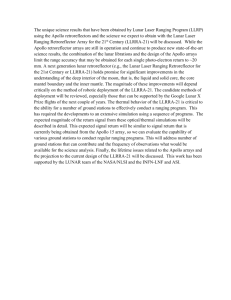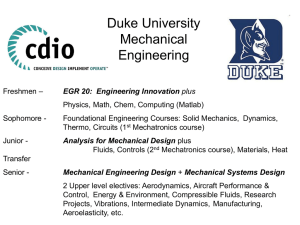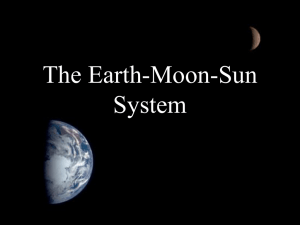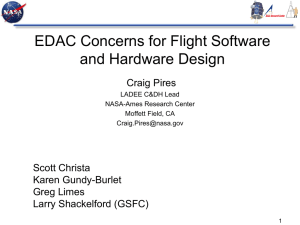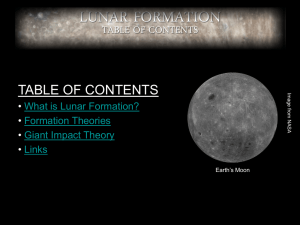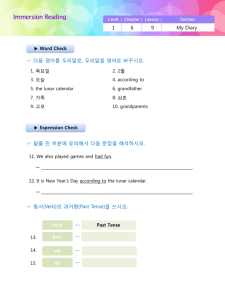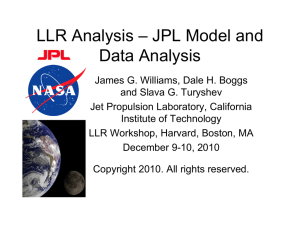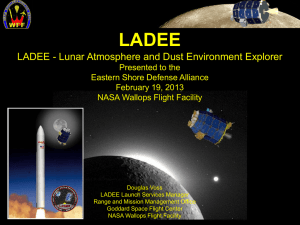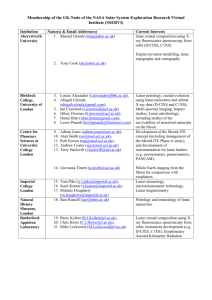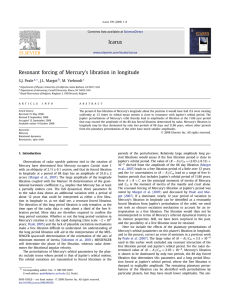The first stage of the constructing the numerical theory of lunar
advertisement
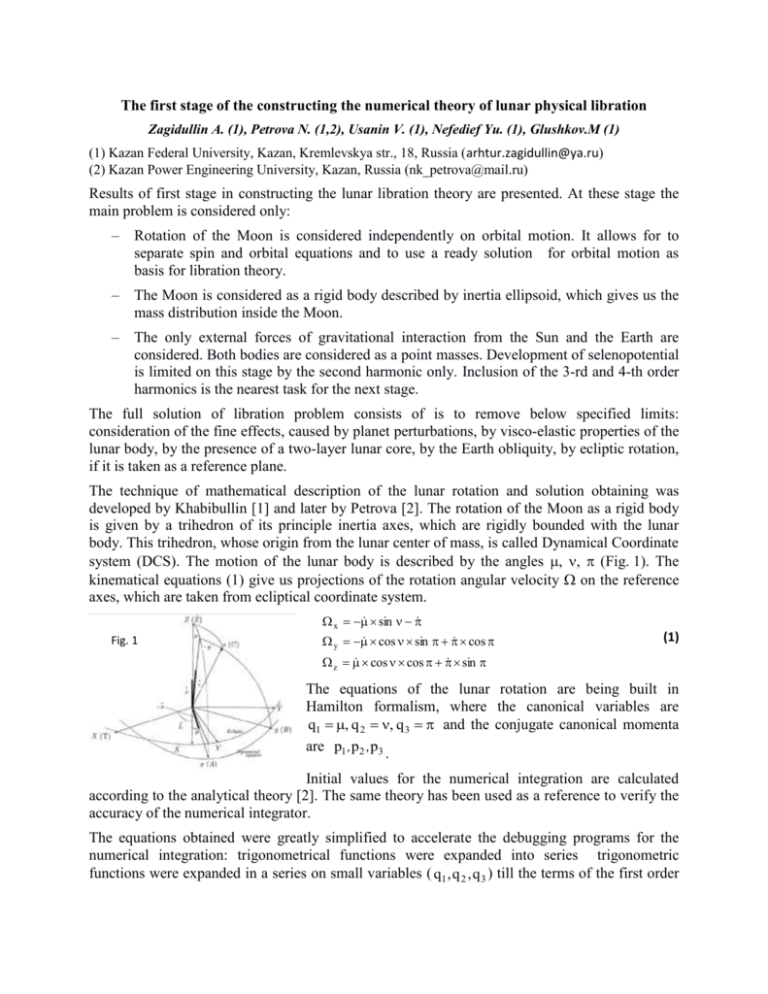
The first stage of the constructing the numerical theory of lunar physical libration Zagidullin A. (1), Petrova N. (1,2), Usanin V. (1), Nefedief Yu. (1), Glushkov.M (1) (1) Kazan Federal University, Kazan, Kremlevskya str., 18, Russia (arhtur.zagidullin@ya.ru) (2) Kazan Power Engineering University, Kazan, Russia (nk_petrova@mail.ru) Results of first stage in constructing the lunar libration theory are presented. At these stage the main problem is considered only: – Rotation of the Moon is considered independently on orbital motion. It allows for to separate spin and orbital equations and to use a ready solution for orbital motion as basis for libration theory. – The Moon is considered as a rigid body described by inertia ellipsoid, which gives us the mass distribution inside the Moon. – The only external forces of gravitational interaction from the Sun and the Earth are considered. Both bodies are considered as a point masses. Development of selenopotential is limited on this stage by the second harmonic only. Inclusion of the 3-rd and 4-th order harmonics is the nearest task for the next stage. The full solution of libration problem consists of is to remove below specified limits: consideration of the fine effects, caused by planet perturbations, by visco-elastic properties of the lunar body, by the presence of a two-layer lunar core, by the Earth obliquity, by ecliptic rotation, if it is taken as a reference plane. The technique of mathematical description of the lunar rotation and solution obtaining was developed by Khabibullin [1] and later by Petrova [2]. The rotation of the Moon as a rigid body is given by a trihedron of its principle inertia axes, which are rigidly bounded with the lunar body. This trihedron, whose origin from the lunar center of mass, is called Dynamical Coordinate system (DCS). The motion of the lunar body is described by the angles , , (Fig. 1). The kinematical equations (1) give us projections of the rotation angular velocity on the reference axes, which are taken from ecliptical coordinate system. Fig. 1 x sin y cos sin cos (1) z cos cos sin The equations of the lunar rotation are being built in Hamilton formalism, where the canonical variables are q1 , q 2 , q 3 and the conjugate canonical momenta are p1 ,p2 ,p3 . Initial values for the numerical integration are calculated according to the analytical theory [2]. The same theory has been used as a reference to verify the accuracy of the numerical integrator. The equations obtained were greatly simplified to accelerate the debugging programs for the numerical integration: trigonometrical functions were expanded into series trigonometric functions were expanded in a series on small variables ( q1 , q 2 , q 3 ) till the terms of the first order q 1 p q 2 (1 1 )p 2 1nq 3 q 3 (1 2 )p 3 nq 2 p 1 Q100( t ) (2) p 2 n 2 q 2 np 3 Q 010( t ) p 3 1n 2 q 3 1np 2 Q 001( t ) of smallness O(q12 , q 22 , q32 ) . In fact, the resulting system of equations (2) corresponds to a linear problem of physical libration. Here the function Qijk (t) are the trigonometric series coming from expansion of selenopotential till the 2-nd order. The advantage of the system (2) is that it allows to obtain exact analytical solutions. This system was solved numerically. The one-step Runge Kutta (RK) method of 4th and 10th orders of accuracy [3] was used to numerical integration. Figures 2(a,b) demonstrate the increasing of the inaccuracy at 10 years interval and with step ½ of day for RK-4 and RK-10, respectively. The graph shows that RK-10 gives four orders better convergence compared to the RK-4. Fig.2a Fig.2b The modern accuracy of the lunar laser ranging has an accuracy of 0.0001 arc seconds for lunar physical libration parameters [4]. One of the planned space experiments is the Japanese project ILOM (In situ Lunar Orientation Measurement). It proposes placing of a small optical telescope on the lunar surface with the purpose to detect the lunar physical libration with millisecond accuracy [5]. That is the observations require a high accuracy for the theory. Integrator RK-4 gives a stable error 5 seconds at the 10-years interval and it is not suitable for the treatment of high accuracy observations. Because of this we take RK-10. Especially since the expenses of time, compared with the RK-4 are negligible, but the errors in the libration angles are growing much more slowly. At the interval of 10 years the difference with the exact analytical solution is not more than a 10 9 second. References: [1] Kabibullin Sh. Nonlinear theory of the physical libration (1966год) Trudy Kazan GorAO (in Russian) [2] Petrova N. Analytical extension of Lunar libration tables. // Earth, Moon and Planets, Vol. 73, 1996. No 1, p. 71-99. [3] E. Haire: A Runge-Kutta Method of Order 10. J. Inst. Maths Applics (1978) 21, 47-59 [4] Williams J.G., Boggs D., Yoder Ch., Ratcliff J., Dickey J., Lunar rotational dissipation in solid body and molten core.// J. Geoph.Res., 2001. V.106, No E11, pp. 27, 933-27, 968. [5] Hanadaet al. Application of a PZT telescope to In situ Lunar Orientation Measurement (ILOM). Intern. Ass. Geodesy Symp. Vol.28, (2005), pp 163-168
